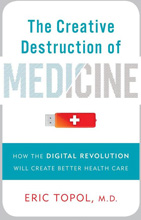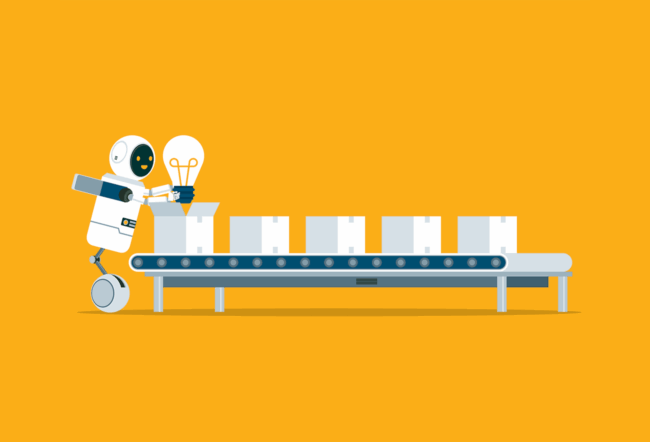In his new book, The Creative Destruction of Medicine: How the Digital Revolution Will Create Better Health Care, Eric Topol argues that medicine is set to undergo its biggest shakeup in history, pushed by demanding consumers and the availability of game-changing technology. Topol — a cardiologist, director of the Scripps Translational Science Institute and co-founder of the West Wireless Health Institute in La Jolla, Calif. — was recently interviewed for Knowledge at Wharton by C. William Hanson, III, a professor of anesthesiology and critical care, and director, surgical intensive care, at the Hospital of the University of Pennsylvania. Hanson’s latest book is titled, Smart Medicine: How the Changing Role of Doctors Will Revolutionize Health Care, published in 2011.
Below is an edited transcript of the conversation.
William Hanson: I thought it might be worthwhile to quickly give you a sense of who I am and where I’m coming from [in this interview]. I’m an anesthesiologist and an intensivist, primarily a surgical intensivist, and serve as chief medical information officer at Penn. So I have some interests that will skew in that direction.
I love the title of your book. There are many people on both sides of this question. Some would say that the creative destruction of medicine is a pretty scary concept, and I think there would be plenty of us who would agree that something drastic needs to happen. You’re obviously in the latter category.
Eric Topol: I’m in the [group that feels] something drastic needs to happen. I think it can happen, it will happen and I’m hoping that we can help facilitate or catalyze that.
Hanson: You have been in a prominent role in terms of questioning traditional medical concepts. Maybe you could describe for the audience what your personal practice is and some of the issues in which you have engaged the traditional medical establishment in the past.
Topol: What I’ve done to try to change medicine in many different ways [includes] research on how to come up with better therapies. These were in large trials, as large as 40,000 patients with heart attacks, but also in [other] ways, such as starting a new medical school with a very innovative curriculum and challenging a drug safety issue which was really important for the public. So I’ve had different experiences over the years.
But what was changing for me was that four or five years ago, we recognized we had this new emerging capability of digitizing human beings, which we’ve never had before. Everybody is used to digitizing books, movies and newspapers, whatever. But when you digitize human beings by knowing the sequence of their DNA, all their physiologic metrics, like their vital signs, their anatomy [and so forth], this comes together as a unique kairos — this supreme opportune moment in medicine.
Hanson: That’s a nice lead in. I want to return to that digitization because it is something I’m dealing with in our IT systems, as I’m sure you are — what to do with the digitized information, how much of it to keep, how to analyze it. But I wanted to come back to your book title and to one of the gentlemen who endorsed the book, Clayton Christensen. He has written a couple of books as you know, including The Innovator’s Dilemma and The Innovator’s Prescription.
Topol: He has written three books on innovation and is renowned for his insights and leadership in [that] space. But there’s a little bit of a difference between us.
Hanson: Maybe you could elaborate on that.
Topol: Yes. I look to him as one of the real guiding lights of innovation. He’s not a physician. In the book, Innovator’s Prescription, he worked with a young physician, Jason Hwang, who is now out at Stanford.
Hanson: Yes, I have met him.
Topol: The difference, though, is that I am coming at it from almost three decades in the medical profession, and I’m not calling for an innovation. He calls it disruptive innovation. I’m looking at a much more radical thing. This is like taking what Clayton has popularized [and making it much bigger] … in terms of how transformative this can be, this whole ability to digitize human beings.
Hanson: In his work, he has talked about the digitization of the music industry, for example, and the film industry. Recognizing that you’re dealing at a much deeper level with the medical side of things, [it has to do with] how products enter the market at the low end and disrupt and take over higher-end products. For me and you at academic medical centers, where we think we’re providing state of the art care, I wonder to what extent we are likely to be made irrelevant by radical disruptions of the kind you’re talking about. What do you think about that?
Topol: I think that the medical community has been incredibly resistant to change. That’s across not just academic medical centers, but the whole continuum of medicine, [including] practicing physicians. But there is a consumer-driven health care revolution out there where each individual has access to their smart phone, all their vital signs and relevant data. There’s an ability to tap into their DNA sequence and all of their genomics. And of course that’s superimposed on this digital infrastructure that each person has now with a social network, with broadband Internet access and pervasive connectivity.
When you combine all this, it is an empowerment, the likes of which we’ve never seen for consumers. If the medical community doesn’t wake up, it’s going to be completely driven by consumers. There are a lot of problems right now. In recent months, there have been articles published in top-tier journals in medicine, asking, for example, if patients should have access to their laboratory tests. I say, how can you even ask that question? The AMA [American Medical Association] is lobbying the government [stating] that consumers should not have access to their DNA unless it’s mediated through a physician, which is amazing to me since the AMA did its own survey of 10,000 physicians, and 90% said they were totally uncomfortable dealing with any genomic data. So we’ve got these kinds of problems going on right now where there’s a real irony [around] emerging data. What should be the ownership, the rights of the individual? The medical community is basically suppressing that from happening.
Hanson: My father was a primary care physician and internist whose medical records were in his office in a file cabinet. He would scribble some notes during the patient visit, during the exam, and then dictate his notes into a Dictaphone which would be transcribed onto some onion skin paper that the file clerk would then put in the file drawer. That was his medical record and his property, and that’s what he sold when he sold his practice. I think what we’re looking at now — and again, I’m again curious as to your sense of this — is a world in which patients are going to be accumulating their own health care data on smart phones and devices in their home and sharing it with health systems and providers as they see fit.
Topol: Yes. I think that’s right. Along the lines of what I was [saying], there was also in an Annals of Internal Medicine [an article asking] whether patients should have a right to access their office notes from their doctor. Even that’s being debated. This is crazy stuff. But I do think there’s a change, a true radical change, that’s emerging in medicine, which is that all this can be digitized, whether it’s medical records or all the things that we’ve been discussing. This is the rightful property of the individual. It’s about their health. I think this is something that — as we go forward from birth or even from the fetal stage, from the womb to tomb — is going to be the story going forward. We have got to reset for that.
Hanson: So coming back to this accumulating the information on your smart phone, you give several examples in the book of how you have not only been a physician, a provider on the one hand, but you’ve actually acted in the role of that smart, emancipated patient. Maybe you could tell us about some of the experiences you’ve had there.
Topol: When I worked as a patient myself?
Hanson: Yes.
Topol: It was really enlightening. When I was in the very early testing of genome-wide scans … in the book, I talked about how I did this too early, before a lot of the glitches were identified. So here I am, I’ve been a cardiologist for a couple decades, and I get my genome-wide scan. The first thing I look up is my risk of heart attack, and I see 102%. I say, “Oh my gosh, I’ve got an even greater than 100% risk. How can you have a greater than 100% risk of a heart attack?”
I wrote in the book, and it’s true, that I called my wife and said, “I don’t think I’ll be making it home for dinner.” But I think that was a mistake. I do have an increased risk for heart attack, but they didn’t have their algorithms and their predictive analytics ready. So fortunately, it didn’t roll out to the public. That, I think, underscores a key principle: All these things, whether they are apps and add-ons to smart phones with bio sensors or whether they’re genome assays, all the kinks have got to be worked out before we have a mass exposure.
I also had [an experience] with the portable ultrasound, the Vscan. I had this horrendous leak of my mitral valve, and I thought I was going to have to sign up for open heart surgery…. Again, it was a software glitch. But both these happened because I had the earliest, too early, access to the technology.
Hanson: I want to return to that in just one second, but the other thing that I thought was amusing was … a situation where your wife was monitoring your brainwaves to see if you were asleep or not.
Topol: The Zeo device is a brainwave sensor you wear on the forehead, [like a] headband. It gets your brainwaves every minute while you’re sleeping, and can project them onto a clock so that anybody can walk in, look at the clock and know what phase of sleep you’re in. So my wife, who tends to be a night owl, comes in soon after [I start] monitoring my sleep phases, looks at the clock and says, “Eric, I know you’re awake, and I want to talk.”
Talk about a wake-up call. That really showed me that this was not just monitoring sleep. It was really quite amusing. You know, when you start monitoring [situations] like that, all sorts of unpredictable things can happen.
Hanson: That goes to [my next] question. The situation I deal with in my administrative role is doctors essentially saying, “You’re jamming too much of this stuff down our throats too quickly. There’s too much change. This new technology or this new approach … isn’t ready for primetime yet.” And as you talk about this in the role of the patient, you’re seeing or experiencing potentially the same sort of thing. I’m curious, how do you answer that?
Topol: No, I don’t agree. I think whenever we can demonstrate that information and knowledge of an individual improves their outcomes — and in the future, it’s going to improve our chances of actually preventing illness, which is the ultimate goal — those are good things. I don’t see this as a “too much information” or cramming issue whatsoever. There is that potential, but when it’s used appropriately, I think it can become invaluable.
Hanson: So how should we, as responsible professionals, decide when something is ready to transition from the laboratory, if you will, to the clinical setting?
Topol: This is, of course, highly specific to the individual and the condition of concern. A perfect example today is a person gets a prescription. Is it right for that person? Is there a potential for a horrible side effect or of the drug not even working? There are many drugs today that we could do a quick genotype [for] to determine that, and we’re not doing it. That gets me highly frustrated.
Just to add a little bit of color to that. A commonly used drug is Tegretol, a carbamazepine, used of course for a lot of different conditions–
Hanson: For seizures.
Topol: Yes. In Taiwan, you can’t get that drug without a genotype that says that you’re not going to have a potentially fatal adverse effect known as Stevens Johnson Syndrome. Well, in the U.S., no one who gets that drug gets a genotype. The chances of getting that potentially fatal adverse effect, which could be preempted, are one in 1,000. There are hundreds of thousands of people taking that drug, getting new prescriptions all the time. So this is an example where we have information, we’re not using it and it’s really unfortunate.
Hanson: People have talked about the idea that the entire classification scheme of taxonomy of diseases is going to be rewritten. We’re both aware of disease descriptions, like consumption and miasma and things, that were used to describe diseases as if they were real a century ago. We now ridicule them and talk about prostate cancer and other diseases. I’m curious as to what you think we’ll be talking about in the next decade once genomes are routinely sequenced.
Topol: You know, I think that is a key point going forward. We will, indeed, have genomic data on most people. It’s obviously still going to be an option years from now. Some people will not want that, and they will buck it. But for the most part, we’re going to have this information very early on in one’s life, and that is going to be, in so many ways, pivotal to guiding not only the proper treatments, but the prevention strategies. It gives us an edge that we never had before. One of the most exciting things [is that] just last Friday, it was announced that USB size sequencing devices can plug into a laptop — this so called MinION from Oxford Nanopore. It took the world by surprise. I wrote about it in the book, but I thought it was still five years off. And it happened all within a year. So this is an amazing jump in our sequencing capability, which will be transformative. [On February 17, Oxford Nanopore Technologies introduced DNA “strand sequencing” on the GridION platform and presented MinION, a sequence the size of a USB memory stick.]
But I think the key point is not to look at it as an isolated sequencing of DNA; it’s just part of a panoramic view, high-definition, of each human being. We have never had these tools before. We have practiced all these years at a population level, whereas now we have the tools to really practice medicine at the individual level.
Hanson: We’re going to wrap up. Maybe you can close with a quick description of what you see personalized medicine looking like, as an anecdotal description of the patient of the future.
Topol: I think if we can get this going into high gear, we will see a far more precise, efficient, participatory and ultimately preventive form of medicine. So it’s very exciting. But the problem is that the medical community is just so darn resistant to change. If we get this moving, I think it’s going to rely on our consumer-driven story here.
Prescriptions won’t be given without knowledge of whether they will work in advance or induce a serious side effect. We won’t have, in the future, the whole issue of blood pressure not being controlled because we will have that on a beat-to-beat basis all archived in one’s phone. For diabetics, glucose will be monitored minute by minute. In fact, pre diabetics — there are a billion of these people on the planet — could actually have their diabetes prevented by [following] lifestyle modification because their phone will be giving them their glucose basically all the time. So there’s all sorts of exciting new ways that each person will have access to data, information, knowledge that, in partnership with their physician, could make an enormous difference in their future health.
Hanson: Great, thank you. It’s been a real pleasure talking to you today, and I look forward to seeing your book.
Topol: Thanks very much. Great to chat with you.



